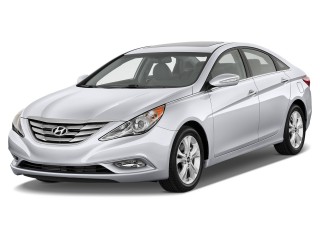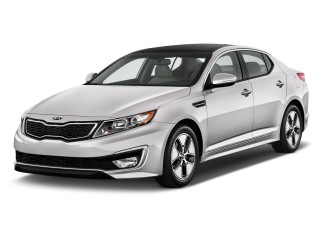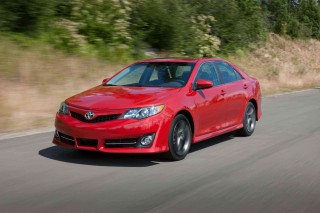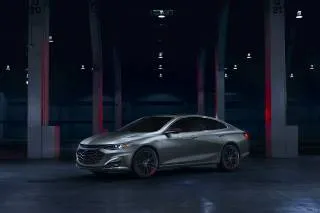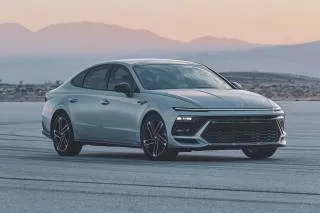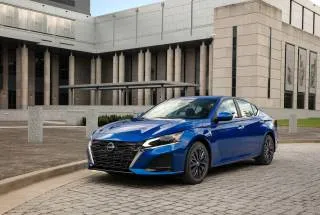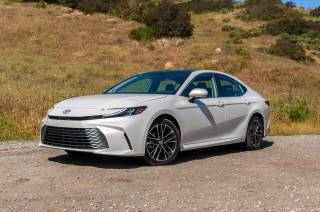Likes
- More nimble than ever
- Four-cylinder fuel economy
- Six-speed automatic is a smooth operator
- Stylish cockpit
- Simple connectivity with Chevrolet MyLink
Dislikes
- Back-seat space and comfort
- Eco mileage lags hybrids--and regular sedans
- Exterior styling isn't cohesive
- Ride impacts over rough roads
- Premium price in a cheapskate class
Buying tip
features & specs
Thinking small makes the 2013 Chevrolet Malibu a more sporty sedan, but doesn't help its rear-seat space at all.
Now that Chevrolet's small cars, like the Sonic hatchback and Cruze sedan, have given shoppers a reason to put the brand back onto their shopping list, it's the job of the 2013 Chevy Malibu to keep GM's fortunes headed in the right direction for the mid-size family-sedan class.
The only hitch, perhaps, is that it's been downsized, as it's a part of a global family of cars, and that betters its performance while it subtracts from its rear-seat utility. The new Malibu fares better against the smaller sedans in its segment than the bigger, heavier hitters--the ones that dominate the top of the sales charts.
The venerable nameplate now rides on a smaller car that's only a fraction of an inch shorter than the previous Malibu, but on a substantially shorter wheelbase. At first glance the new Malibu looks much leaner, though. The front end is lower and a little slimmer, with a more proud Chevy bowtie affixed to its grille, and more delicately shaped headlamps faired into its front fenders. It's sculpted more down its sides, and very cleanly shaped at the rear glass for aerodynamic smoothness. That's also where it loses some distinctiveness that even squared-off, Camaro-esque taillamps can't punch up. Inside, it's more assertive and distinctive: the wraparound theme drops the dash height and frames a low-slung set of gauges with a good mix of materials and well-placed controls.
Three four-cylinder powertrains make up the Malibu performance portfolio. The base four-cylinder makes 197 horsepower, and with a six-speed automatic, the front-drive Malibu has smooth acceleration that's competitive, if not overly quick. An Eco model adds mild-hybrid technology that trims consumption and boosts highway mileage from the base car's 34 mpg to 37 mpg--better, but not exceedingly high, compared to the new Nissan Altima's class-leading 38-mpg highway rating. The turbo Malibu spools out 259 horsepower and a 0-60 mph time of 6.3 seconds, but it's more a V-6 replacement than a truly sporty sedan. With electric power steering, the Malibu points its way better than most sedans with similar systems, and the ride's much more taut than in the past, though it transmits some impact harshness on road surfaces where longer-wheelbase cars with more suspension travel simply would gloss over them. There's moderate body roll, even on Turbos, and in all, the Malibu's handling lands it short of the Accord and Fusion in fluid driving feel.
Front-seat passengers will find excellent supportive seats in the Malibu, and a wealth of places to stash smartphones, change, cables, and other carry-on items. The back seat suffers the shorter wheelbase: there's less knee and head room than in most competitors, and the cushion is low and short, making it more suitable for small adults and children. The trunk is large on gas-only models; Eco sedans lose a couple of cubic feet to their battery pack.
Safety scores have been top-notch, with the Malibu earning the NHTSA's five-star ranking and the IIHS' Top Safety Pick. Ten airbags are standard, and so is Bluetooth, while a rearview camera is also standard on most models. Lane-departure warning and forward-collision warning systems are options.
Pricing for the new Malibu starts from $23,150. That's a substantial markup over some base vehicles in the class with similar standard features. The Eco version is priced from $25,995, and turbo Malibu sedans will be priced from $27,710. The Malibu's connectivity features aren't the most exotic in class, but they do bridge the most important smartphone functions with the sedan's audio system. Chevy's MyLink software lets drivers stream Internet radio apps through the sound system, or listen to podcasts through Bluetooth streaming, though text-to-voice functions common on other systems aren't included.
2013 Chevrolet Malibu Styling
The Malibu lacks a cohesive look outside; it's heavy in the front, lighter at the rear, but the cabin's quite stylish.
With so many stunning new looks worn by the latest batch of mid-size family sedans, the 2013 Chevy Malibu has a tough task ahead of it. Its exterior styling combines cues from a few bags of tricks, and the result doesn't connect as well as the radical departures from Hyundai or Kia, or for that matter, Ford or Nissan.
The new Malibu looks much smaller than it did last year, though it's not even a half-inch shorter overall. The front end is lower and the headlights are tapered in more effectively for aero smoothness, and there's a VW-like stagger to the grille and headlamps. The grille has a triplet of air intakes that add up visually to a more handsome look than before. The Eco models have their own front air dam with some pretty emphatic elbows embossed into the lower corners, and all versions have active aero shutters at the front to smooth airflow. A big Chevy bowtie seals the deal.
The aerodynamics start to have their way with the shape at the corners of the headlamps and at the small, set-off side mirrors. Down the sides, the Malibu picks up some subtle sculpturing, and by the time the sheetmetal wraps around the rear pillar, it's started to resemble Fortes and Camrys. The decklid and taillights are tiered like those on the last-generation Camry, too, but the rounded corners of the Malibu's high rear lamps bring it more in line with other current Chevys. GM cites a lot of Camaro influence in the Malibu's details, and it's easy to see some of the heritage appeal molded and shaped into the taillamps, but it's not altogether related to what's going on at the front end. Whatever its shortcomings in execution, the Hyundai Sonata's look is a dynamic calling card for the brand in a way this new Malibu shies away from being.
A thick steering wheel is mounted ahead of large, square-ringed gauges. The dash plays host to the same plastic materials used in the Chevrolet Volt, though its used in the Malibu for non-capacitive buttons and to frame the touchscreen, which sits front and center. That screen is flanked by large, easy-to-use knob controls for climate and and audio functions. Designers took some visual heft out of the dash by cutting strakes across the surface and glinting it with metallic trim, but the dash itself doesn't seem thick enough to warrant the fuss. There's also some trim on the Eco model that seems to want to be woodgrain, except up close it's more metallic and woven in appearance. Taste points aside, it all feels good to the fingertips.
2013 Chevrolet Malibu Performance
We like the crisp steering on base and LTZ models, but non-turbo Malibus aren't fast, and some ride impacts can feel harsh.
The 2013 Chevy Malibu joins a growing set of family sedans that are giving up on six-cylinder power. This year, its engine bay will be occupied only by four-cylinders, in this case a trio of four-cylinders that put value, efficiency, and acceleration under the spotlight.
Does the change-up deliver on its promise? The net effect on performance is an improvement in some subjective ways, but the old V-6's grunt is sorely missed, at least until the third powertrain becomes available.
A 197-horsepower, 2.5-liter four is the base engine in the 2013 Malibu, and it's teamed to a six-speed automatic. The transmission's the savvy part of the equation, with smart kickdowns and smooth upshifts, and only really lacking a more useful manual-control mode than the clicker placed on the console-mounted shift lever. The engine itself? It's no more pedestrian than the base four-cylinder engines in other family transportation, with acceleration in the 8-second range. What it does--thanks in part to a very well-insulated cabin--is deliver quiet acceleration, several degrees less noticeable and less droning than the Sonata or Passat. Gas mileage is rated at 22/34 mpg, somewhat lower than the current Fusion, the Optima and Sonata, and markedly lower than the CVT-geared Nissan Altima--which rivals the Malibu for subduing its drivetrain noise.
Next up in the Malibu drivetrain ladder is a mild-hybrid model that GM doesn't refer to as a mild hybrid, though it fits the technical description. It's a version of the eAssist technology found on Buick models, teaming a 2.4-liter, 182-horsepower four-cylinder engine and a six-speed automatic. The gas engine's power is augmented by a 15-kW motor, a lithium-ion battery pack housed behind the rear seats, a stop/start system, and regenerative braking.
Here's how it works. The gas engine delivers almost all the power, all the time, but the batteries can distribute some of their charge as torque. That enables taller transmission gears, which lets the engine turn at lower speeds at times, which boosts fuel economy. The stop/start system shuts the car off to conserve gas at stoplights and restarts it automatically. And finally, the regenerative braking recharges the batteries.
Whether you consider it a hybrid or not, the Malibu Eco does a good job of forgetting it's blending gas and electric power. It's smooth, and the windup of the four-cylinder engine is tamed well. In terms of outright performance, it's a bit slower than the base four--a penalty of its battery weight, when the Malibu is already a heavy vehicle in its class. The payoff: the Malibu Eco delivers 25/37 mpg, a cut above most non-electrified vehicles in the class, but still lagging the new Nissan Altima by a mile per gallon on the highway cycle.
Finally, there's the Malibu Turbo, with the on-paper power to draw close to the likes of the Sonata turbo and six-cylinder Accord, Altima, and Passat. It's certified at 259 hp and 260 pound-feet of torque, and mated to a six-speed automatic, with a 0-60 mph time estimated at 6.3 seconds. Straight-line performance is clearly in the right leagues, and the powertrain feels flexible across a wide range of driving scenarios--it's quiet enough in highway cruising, and the automatic's geared to accommodate some sporty driving, though the tap-shift control for manual gear calls tells you everything about the intent here. There's no option for paddle controls, something a true sport sedan would offer.
Surprisingly, the new Malibu is now a handler and offers responsive electronic power steering feel far superior to that in the Kia Optima and Hyundai Sonata. It's direct, exactly what steering response should be, and doesn't rely on weighting gimmicks to emulate a sensation of steering feel. Electronic power steering is never going to be as precise as its hydraulic forefather. The Passat delivers more precision if that's what you want. Otherwise, the Malibu's steering solution reduces fuel consumption and makes the car feel smaller behind the wheel.
In our experience with the entire Malibu lineup, the front strut/rear multi-link suspension doesn't have the fluidity of the latest Altima, or the taut, athletic feel of the new Fusion. Some bumps upset its composure, while it hangs on to a moderate amount of body roll, even on Turbo models. It's at once not quite as cushy as the previous Malibu, and not quite up to the new class standards. Especially on the Turbo, we find ourselves expecting more athletic responses--in part because of the powertrain, in part because of the smaller dimensions. It's no Fusion, and that's fine; not every sedan needs to be quite that taut and firm. It does need to be in agreement with itself, though, and the conflicts between steering and ride quality feel more like a Camry compromise than a shot at best in show.
2013 Chevrolet Malibu Comfort & Quality
Front seats are very well shaped for long-haul comfort, and storage space is good; the back seat is low and on the skimpy side.
The Malibu has excellent front seats and a generally good level of fit and finish. It's on the smaller end of the mid-size class in wheelbase length, and that cuts down on back-seat space and comfort.
Those front seats are some of the best we've experienced in a mass-market GM product. We've been pleasantly surprised by the seats in the Cruze and Sonic in the recent past, and the Malibu performs even better for long-distance driving comfort. The front seats are deeply pocketed, and have a wide range of adjustment to both cushions. The low-slung driving position goes well with the the low-set gauges, and even six-footers can find a good driving position with the telescoping wheel. After a half-dozen hours in every available Malibu, over two separate test drives, we've still felt fresh. But the Malibu's active headrests deserve a special nod; they don't protrude forward as those in some competitors.
Moving into the back seat, the decision to recast the Malibu as the smaller, sportier Chevy mid-size sedan has its compromises. The Malibu's wheelbase is about 4.5 inches shorter than before, and it delivers 42.1 inches of front-seat leg room and 36.5 inches of rear legroom. Compare that with the Hyundai Sonata, at 45.5 inches front and 34.6 inches rear, or the titanic VW Passat at 42.4 inches front and 39.1 inches rear, and it's clear the Malibu sizes up more directly against the current Ford Fusion--or even the new Dodge Dart. It's gone from having one of the most spacious and comfortable rear seats, to one with much less elbow room.
The back seat is shaped in such a way to maximize the numbers, and that leaves it less comfortable for adult passengers. The rear bench is short and low, and still a little lacking in headroom for the tallest adults. We'd gladly give up a couple of tenths of an inch for a rear seat in the Malibu that sat a little higher, or was a little longer.
Trunk space is better, with more than 16 cubic feet of storage space. On the Eco model, it's slimmed down to make room for 2.0 cubic feet of Eco batteries; in all, the Eco trunk measures 14.3 cubic feet, larger than that found in many hybrids.
Aside from the Malibu's rear seat foibles, GM engineers have carefully shrunk the car in other ways. The center console doesn't seem to have room for a storage bin, but the touchscreen flips up to revealing a dash storage space--though, sadly, it doesn't have USB input or a power point for charging. Those are located in the center console.
2013 Chevrolet Malibu Safety
The Malibu earns knockout scores from both sets of crash tests, and has almost everything we like to see as standard equipment.
In its maiden year on the market, the newest Chevy Malibu has already earned the best safety scores possible.
The National Highway Traffic Safety Administration (NHTSA) gives the Malibu an overall rating of five stars, including sub-ratings of five stars for front- and side-impact performance, and four stars for rollover resistance. The Insurance Institute for Highway Safety (IIHS) likewise has lauded the Malibu, giving it "good" scores in all tests including roof strength, which lands it a Top Safety Pick award; although in the newest small overlap frontal test, the Malibu only achieves 'marginal.'
All Malibu sedans come with extensive standard safety features, including 10 airbags--among them, rear-seat side and front-seat knee airbags. Stability and traction control are also standard, as are active headrests and anti-lock brakes with tire-pressure monitors.
The Malibu also comes with OnStar hardware and six months of service that includes automatic-crash notifications and remote door unlocking.
On the tech front, Bluetooth comes on all versions, and a rearview camera and rear parking sensors are standard on Eco, LT and LTZ models. A safety package on those three trim lines adds forward-collision alert and lane-departure warning.
Visibility from the Malibu's driver seat is good, even with its low-slung driving position, but its side rearview mirrors are somewhat small.
2013 Chevrolet Malibu Features
Bluetooth and satellite radio are standard, but the USB port isn't; MyLink is a smart phone connection.
The 2013 Chevy Malibu meets some of its toughest competitors head to head in terms of standard features, though its base price of $23,150 is higher than some notables in the mid-size sedan class--the Altima, the Sonata, and the Optima among them.
The base Malibu LS comes standard with power windows, locks, and mirrors; air conditioning; an AM/FM/CD player with satellite radio and a USB port; Bluetooth; cruise control; keyless entry; tilt/telescope steering; steering-wheel controls; and 16-inch wheels.
The Eco, LT, and LTZ models add another set of standard infotainment features that enable better connectivity, and put the Malibu on good footing in the class. All get a 7.0-inch touchscreen and Chevrolet MyLink infotainment, which allows drivers to stream Pandora internet radio and catch up with podcasts on Stitcher via Bluetooth streaming. Standard equipment on Turbo LT models includes 18-inch aluminum alloy wheels, remote start, power driver seat, and steering-wheel-mounted audio controls.
One thing MyLink doesn't do is voice-to-text and text-to-voice communication. The Malibu doesn't deliver either of those features, which are available on Camry and Sonata and on Ford's MyFord Touch-equipped vehicles. GM says it's evaluating the safety of the features.
The Malibu LTZ has the most extensive standard features, at a base price of $28,590 for the four-cylinder or $30,925 for the turbo. It gets 18-inch wheels, fog lamps, LED taillamps, leather seats, heated front seats, power front seats with lumbar adjustments, remote start, and a power sunroof.
Buyers can opt for a safety package on LT and LTZ trims, which includes forward-collision alert and lane-departure warning; Eco and LT models can be optioned with leather-trimmed seats and heated front seats. Keyless entry, push-button start, 19-inch alloy wheels, HID headlamps, and memory front seats are available on the LTZ trim.
2013 Chevrolet Malibu Fuel Economy
Gas mileage is higher across the board, but the Malibu Eco isn't the equal of a true hybrid--or the latest four-cylinders, even.
The Malibu bows with an all-four-cylinder engine lineup that significantly boosts fuel economy over the last version. It also gets other fuel-saving features, such as active shutters that smooth the airflow at its front end, lower rolling-resistance tires, and lighter-weight materials. It's not as efficient as other roomier mid-size sedans, though.
The base Malibu engine is a 2.5-liter four-cylinder, with 192 hp, mated to a six-speed automatic. The combination is rated by the EPA at 22 miles per gallon city, 34 miles per gallon highway. It's a marked increase for the Malibu, though the current Nissan Altima sets the benchmark with a 38-mpg highway rating.
An available 2.0-liter turbo four is good for estimated EPA ratings of 21 miles per gallon in the city and 30 miles per gallon on the highway. The same powertrain is fitted to vehicles across the GM lineup this year, from the Buick Verano to the Cadillac ATS.
The highest-rated gas mileage in the Malibu lineup will come in the form of the Eco, already on sale. With the highest fuel economy ever for a Malibu, the Eco model uses GM's eAssist technology--a set of lithium-ion batteries and an electric motor that recapture energy from regenerative braking and enable start/stop technology and other fuel-saving measures.
The Malibu Eco is rated by the EPA at 25 miles per gallon city, 37 mpg highway. Lagging the base Altima in gas mileage, the Malibu Eco neatly divides the non-hybrid and hybrid versions of strong-selling sedans like the Sonata (24/35 mpg or 35/40 mpg), and the 2012 Ford Fusion (23/33 mpg and 41/36 mpg), but fades when compared with the new Camry Hybrid's 43/39-mpg rating. GM says the Eco delivers almost 600 miles of range on a tank of gas.






































































































